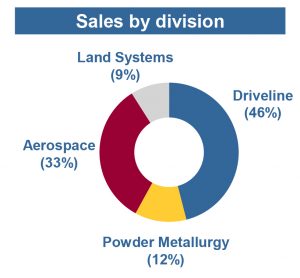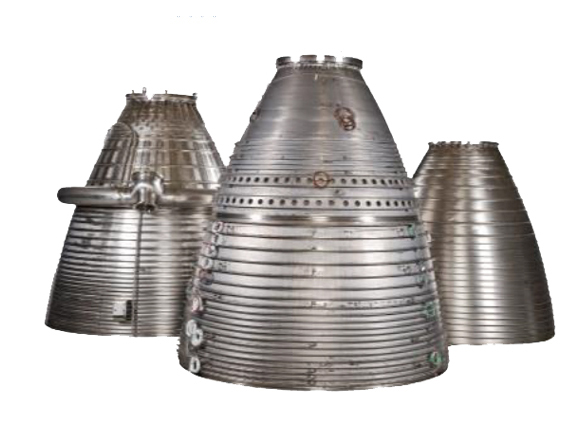GKN Aerospace enhances its global position as Tier 1 supplier and leverages its Additive Manufacturing expertise
June 8, 2016
GKN Aerospace is one of four divisions within UK-based GKN plc, providing around one third of total group sales of £8 billion in 2015. The other divisions include Driveline (automotive) at 46%, Powder Metallurgy at 12% and Land Systems at 9% (Fig. 1).

Fig. 1 GKN Aerospace is the second largest division within GKN after Driveline
The increase in GKN Aerospace’s sales from £700 million in 2006 to over £2.5 billion at the end of 2015 has seen the business consolidate its position as one of the most comprehensive global Tier 1 suppliers to the aerospace industry.
Today the business specialises in airframe structures, engine systems, electrical wiring, and window transparencies, whilst also offering landing gear and MRO services.
Kevin Cummings, Chief Executive Office of the aerospace division said at a recent media briefing in London that the remarkable growth of 8-10% per year achieved over the last ten years had been through a combination of organic growth and acquisitions. “Future growth is assured through $3.5 billion of new business having been acquired in 2015,” stated Cummings.
In October 2015 GKN Aerospace completed the acquisition of Fokker Technologies of the Netherlands, which strengthened GKN Aerospace’s aerostructures capabilities and added electrical wiring systems, landing gear and associated services. Cummings stated that the Fokker acquisition was an excellent fit for both companies, making GKN Aerospace the second largest global Tier 1 supplier to the aerostructures and engine systems sectors, whilst being the third largest supplier of electrical wiring systems.
The company puts itself as the leading global Tier 1 supplier of special products such as window transparencies for flight deck and passenger cabin windows, ice protection systems and lightweight missile canisters. It counts among its customers most of the major aircraft and aero engine producers including Airbus, Boeing, General Electric, UTC, Lockheed Martin, SNECMA, Rolls Royce, etc. The commercial to military aerospace customer balance was reported to be 75% to 25%.
Additive Manufacturing a prime focus for future growth
Chris Gear, Chief Technology Officer, also speaking at the media briefing said that key to sustaining above average market growth is for GKN Aerospace to continue to expand its technology and product capabilities. In this regard the company sees Additive Manufacturing (AM) as one of the prime focuses for future growth especially for advanced metallic structures which can achieve both weight and cost savings for the user.
Gear said that GKN Aerospace has established global centres of excellence for AM in the USA, Sweden and the UK using a variety of AM processes including Electron Beam Melting (EBM), Laser Powder Bed (LPB) and Stereolithography (SLA). He stated that a key objective was to develop large scale deposition systems which can produce large near-net AM preforms for engine and airframe structures, as well as optimised structures such as large bulk heads, wing ribs and spars which would be too large for powder bed AM processes.
AM requires much less machining than traditional forgings or castings by only adding material where needed. It can offer weight savings of 15-30% over traditional processes, stated Gear. Titanium AM parts produced for ULA’s Vulcan rocket engine in the USA are just one example of a large AM part produced by GKN Aerospace already in use. Fig. 2 shows the Vulcan rocket application where the individual large Ti alloy AM parts have been welded together to form the casings.

Fig.2 Vulcan rocket engine casing produced by GKN Aerospace using fine scale wire additive manufacturing
GKN Aerospace is also using small-scale deposition processes such as laser powder bed to produce smaller near-net higher detailed shapes. AM can also be used to directly deposit additions such as bosses onto larger structures, or be used for the modification of and repair of high value engine and airframe components. GKN Aerospace states that it already has metal AM bosses flying on civil aircraft engines.
EBM can also produce very near net shape and structurally optimised, small to medium sized engine and airframe components and the company has teamed up with AM specialist Arcam AB in Sweden to optimise the EBM process for aerospace applications.
GKN Aerospace firmly believes that AM processes will revolutionise the manufacturing of aerospace components by enabling new, efficient, lightweight designs to be created and new, specially tailored higher performing materials to be adopted. GKN has established a titanium and Ti alloy powder manufacturing facility at Hoeganaes Corp., a leading global metal powder producer based in Riverton, New Jersey, USA, and part of the GKN Powder Metallurgy division.
GKN Aerospace will also draw on the know-how of the Powder Metallurgy division for the production of precision engineered products and both divisions will share the knowledge gained from their growing involvement and expertise in the use of Additive Manufacturing.
Gear stated that static and dynamic property data has been established for a range of titanium and titanium alloy powders used in AM which showed good results compared with equivalent cast alloys. The company is presently not prepared to share the obtained property data except through collaboration with end users. It will, however, share some of its achievements in metal AM at the forthcoming Farnborough Air Show, which takes place in the UK, 11-17 July, 2016.
















